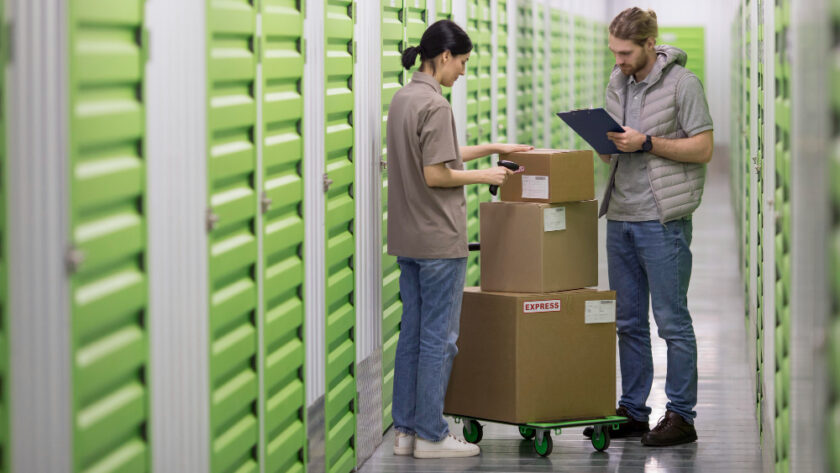Self storage in Glasgow has become an essential solution for individuals and businesses facing space constraints. In this blog, we’ll dive into the practicalities and benefits of using self storage facilities in Glasgow.
We’ll cover everything from selecting the appropriate unit size for your needs to understanding the security features and insurance options available. Our focus is on providing clear, expert advice for effectively utilising self storage in Glasgow, whether for personal belongings, business inventory, or during transitional life phases. Expect insights on optimising storage space, navigating different storage options, and best practices for packing and organising your items in a Glasgow context.
Self Storage in Glasgow for Beginners
People use Glasgow self storage for many different reasons. While relocating, selling home, or being away from the house, your furniture and belongings need temporary homes. Others are downsizing for retirement or caring for an ageing parent and need to reorganise their home and belongings.
| Topic | Details |
|---|---|
| Understanding self-storage | Introduction to the concept of self-storage and its common uses in Glasgow, such as during relocation, downsizing, or home remodelling. |
| Finding the right facility | guidance on how to locate storage facilities in Glasgow, including tips on researching online, checking customer reviews, and considering proximity to your home or workplace. |
| Choosing the Right Unit Size | Advice on selecting the appropriate unit size based on the quantity and type of items to be stored, with examples of what can fit in different-sized units |
| Cost Considerations | Overview of typical costs associated with renting a storage unit in Glasgow, including deposit fees, monthly rental rates, and potential additional costs like insurance or climate control |
| Security and safety | Information on security measures to look for in a storage facility, such as CCTV surveillance, gated access, and individual unit locks |
| Preparing Items for Storage | Tips on how to pack and prepare items for storage, including using the right packing materials, labelling boxes, and advice on protecting delicate items |
| Accessing Your Stored Items | explanation of how and when you can access your stored items, including facility access hours and any rules or restrictions. |
| Contract and Terms | What to look for in a storage unit lease agreement is understanding the terms and conditions and knowing your rights and responsibilities as a renter. |
| Managing Your Storage Space | Strategies for organising your storage unit efficiently include creating aisles, storing frequently used items at the front, and using shelving. |
| Ending Your Storage Rental | Procedures and best practices for ending your storage rental agreement, including notice periods, cleaning out your unit, and ensuring all items are removed |
This table provides a comprehensive guide for beginners, covering all the essential aspects of using self-storage facilities in Glasgow, from selecting the right unit to understanding contractual obligations.
1. Setting up
As with any business endeavour, starting up a self-storage business can be daunting yet lucrative if approached with careful research and planning. To start off the process of starting in this industry, create a business plan that includes key information about your target market’s demographics and income levels, as well as research on local competition to differentiate your company from them and then create projections of expenses and revenues so as to see whether your venture will become financially sustainable.
Once you have an approved business plan and budget in place, the next step is securing funding for your venture. Options for funding can range from using personal funds or approaching investors interested in supporting your company’s expansion to crowdfunding platforms, which allow multiple contributors to fund startups, or applying for loans from financial institutions or SBAs.
Establishing your brand presence and developing a website are integral parts of starting in self-storage. Doing this will allow your company to promote itself and attract potential customers, while you can also utilise social media and digital marketing tactics to spread the word about its services.
Make sure the contact details of your customers are consistent across all online channels, which is known as NAP consistency and is essential for attracting new customers while keeping existing ones. Check that your website, Google Business Profile, and any other profiles match up correctly so potential customers can locate you easily. Once your business has an effective online presence, it can begin generating revenue and growing its bottom line.

2. Choosing Your Unit
Self-storage units can be an invaluable resource when you find yourself overwhelmed with stuff but lack enough room to store it all. From clearing out clutter in the home to expanding business operations, a suitable self-storage space will allow you to clear away excess items while creating more space.
When selecting a storage unit, you must consider size, price, and any restrictions or requirements carefully. Furthermore, make sure your monthly payments are made on time while reviewing the lease contract in depth to avoid late fees from facilities that charge them; this way, you’re better prepared.
Self-storage facilities often provide features like security monitoring, temperature control, and insurance to protect items of high value or extreme sensitivity. You may wish to pay extra for these features if necessary; otherwise, if your items are less costly and you won’t need them as much, you could save money with basic solutions.
Once you have chosen the ideal self-storage option for you, it’s time to plan and find a location for your stuff. Keep in mind when and how often you will access items stored there, as this will determine both where to place them and which size unit would work for you. Also, keep in mind the distance from home or work so you can easily access it when necessary.
3. Packing
Self-storage facilities often sell boxes, locks, and packaging supplies to help their customers pack efficiently. Truck rentals may also be available to transport belongings into the facility. Customers usually provide their own lock for their unit, as employees of these facilities do not have access to what lies within it.
Label your boxes when packing for storage to make finding items much simpler and also prevent any heavy objects from crushing them. If you don’t own a label maker, write out their contents using a marker or masking tape as a quick and effective solution.
Consider carefully when storing items. Place frequently needed items near the front and long-term needs at the back. When possible, stand items up rather than lying them down, as this will maximise space utilisation in your storage unit and save time trawling through everything to reach what you need.
An essential step in developing a self-storage property is obtaining the appropriate zoning approvals from the local government or municipalities. This may take some time, and professional planning assistance from land planners, architects, and civil engineers may also be necessary. You should also hold neighbourhood meetings in the area to receive feedback from residents and businesses and address their concerns accordingly.
4. Moving Your Stuff
When moving your belongings into storage, there are a few key considerations you’ll want to remember. One key strategy for self-storage is packing efficiently, which means placing items you will use regularly at the front and those that could potentially go unseen for some time at the back of the unit.
Labelling your boxes is another wise move. Once packed and stored away, it can be easy to lose track of what lies within each container; marking them will help you quickly identify those containing extra kitchen utensils or sports equipment for later.
If you’re using a climate-controlled or drive-up storage facility, it is wise to keep an accurate record of everything that has been stored, along with where in your unit each item resides. This will prove extremely helpful should anything need to be retrieved from storage in an expedient and hassle-free way.
People rely on self-storage facilities for various reasons. From downsizing for retirement or caring for an ageing parent to moving into a smaller apartment, life changes often necessitate the need for temporary homes for your belongings.
United States cities boast numerous types of self-storage facilities, from conventional storage units and climate-controlled units to drive-up facilities that require monthly rental fees for the storage of belongings. If you are interested in opening one yourself, be sure to get more information from your municipality regarding zoning laws and requirements before beginning construction of one of your own.
5. Accessing Your Stuff
Prior to renting a self-storage unit, be sure to inquire about its amenities and services. Such features could include online bill payment, video surveillance systems, and security gates. Some states also regulate specific commercial statutes that govern how owners charge tenants, such as service fees for bounced checks.
Many individuals require temporary storage to help declutter and organise after undergoing remodelling or renovation projects in their home, while others need somewhere to store furniture and belongings until their space is complete. Divorces and breakups often necessitate extra storage space until things return to normal.
Self-storage offers an easy and affordable way to create extra space without the expense and inconvenience of moving. By carefully considering and estimating the size of your storage unit before packing, you can ensure everything fits properly and that accessing items quickly when needed will not be an issue. Simply stacking boxes neatly while dividing larger items into sections can make life easier when searching. Make sure all boxes are labeled so items that will be most frequently needed can be placed nearer the back while less frequently used items can go in front.



